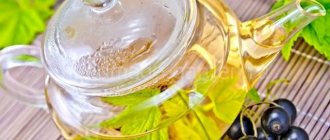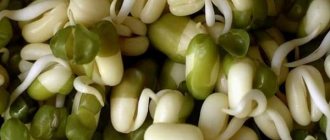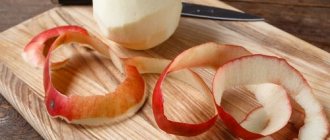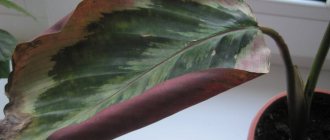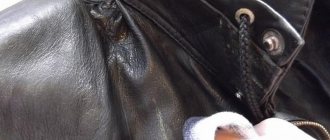If you want to dry the leaves as quickly as possible, and at the same time you don’t care about their final appearance, then you can use an oven instead of a microwave. Take a clean baking sheet and place pre-washed and dried leaves on it in a thin layer. In this case, the leaves will have to be pressed to the surface of the baking sheet; they should fit as tightly as possible to it.
The oven should be heated to 100 degrees. By increasing the heat above this temperature, you will not dry out the leaves, but will contribute to their wilting, darkening and curling.
How to dry leaves with an iron?
In most cases, leaves are necessary for children of preschool and primary school age. Using leaves, you can make beautiful applications and crafts, the main purpose of which is to develop creative thinking, as well as fine motor skills.
How to dry leaves with an iron:
- The simplest and most common option, which allows you to get perfectly even, smooth leaves, suitable for crafts. Under no circumstances should you use a cloth or very high heat for drying.
- The best option would be to select the silk mode, or a delicate fabric such as wool. You need to take an A4 sheet, it must be white. The leaves are laid out on a sheet and covered with another sheet on top.
- It is necessary to turn on the iron and iron from side to side for several minutes. It is worth placing on a hard surface so that the leaves are not pressed or wrinkled. This will prevent crumbs from appearing and leaves from breaking. It is necessary to repeat the manipulations until the leaves are completely dry.
Herbarium
What can you do to make clothes wrinkle less?
Sometimes, even if you have an iron nearby, you don’t feel like ironing or you simply don’t have time for it in the morning. To avoid daily ironing, use the following tips:
Set your washing machine to the “No Crease” or “Easy Iron” mode. Spin minimally, this will also help get rid of heavy wrinkles after washing, and you won’t even have to iron things. If you wash by hand, also do not wring out the laundry.
Let the water drain on its own. Products with the addition of synthetics wrinkle less: pay attention to the composition of the fabric when purchasing. If you are going on vacation, fold your things in a roller or roller. Use steamers, steam generators and similar household appliances. They will help you easily and quickly deal with unevenness in textiles.
Each type of clothing has its own rules:
It is more convenient and correct to iron a skirt or shirt on a board or table. Start with the front and collar. Pockets are ironed separately. The back is on the wrong side. The sleeves are smoothed last, carefully stretching the fabric. If your blouse or skirt has decorations made of beads or other materials, it is better not to iron underneath them. The dress must also be ironed on a flat surface, using smooth movements, adjusting the details. Each type of material requires a certain temperature. For delicate fabrics, such as silk, it is a maximum of 60 degrees. Ironing a T-shirt or tank top is easier than any other item. Although they often do not require ironing at all - cotton products quickly smooth out on the body. If they are ironed, it is done in one go. A T-shirt with a print is ironed on the inside so as not to spoil the design. The most difficult item to iron is dress pants. First you need to iron each pant leg separately. If the fabric allows, do it from the outside. To secure the effect, go through the iron from the inside out. For convenience, lightly moisten the trousers in the area of the future shoots. They need to be ironed sharply. Use the steam setting on the iron. Wool items such as sweaters or pullovers are ironed in the same way as shirts. From the top to the back and sleeves. Choose a suitable temperature for these fabrics. Ironing a blouse is difficult because such items are usually made of synthetic fabrics: polyester, chiffon. You need to be very careful with them - an incorrectly selected temperature will have an extremely negative impact on the product. Unbutton sleeves and buttons before ironing
With special attention you need to iron the seams of the fabric that connect the chest and back, valves and scallops. You don't have to iron your jeans at all; they don't wrinkle much. But if you decide, it’s easy
The trouser legs are processed separately. You can choose a higher temperature; it’s difficult to burn jeans.
How to dry leaves for crafts?
The simplest, but not the fastest, method is using a press. This option is used when flat plants are needed and volumetric inflorescences are not required.
How to dry leaves for crafts:
- In this case, leaves or small flowers are usually placed between the pages of the book, which is covered with a press on top. On average, the drying period is about 1 week.
- If the buds are large and the leaves are fleshy, then the time may increase. This method will not work if you urgently need to make a herbarium and dry leaves for crafts for school. Therefore, the ideal option would be to use a hairdryer.
- To obtain the raw materials for crafts, you need to separate the leaves on a flat and clean surface and turn on the hair dryer at medium power. Do not turn on very hot air under any circumstances, as it will change the color of the leaves and inflorescences.
- If you do not want the inflorescences to become cloudy, pale or change color, then be sure to turn on the hairdryer on medium heat. Please note that you should not dry the plants completely right away. Allow the leaves to sit from time to time. Otherwise, they may become overly dry and simply fall apart after drying.
Herbarium
Alternative blow drying
Microwaves and ovens are not the best way to obtain a herbarium. In addition, you have to periodically monitor the safety of the petals. The advantage of a hairdryer is that the flowers do not darken. Most parents, when preparing a herbarium for their child for school, dry the plant using this device. A very ordinary hairdryer without any bells and whistles will do. The main thing is that you can regulate the speed of hot air supply. If you turn on the device at full power, the leaves may quickly curl. In order for the herbarium to turn out well, the plant is allowed to “rest” from time to time, and then dried again with a hairdryer.
How to quickly dry leaves for a herbarium?
To dry voluminous flowers and preserve the natural shape of the buds, you can use absorbers and substances that absorb moisture. The ideal option would be borax and silica gel.
How to quickly dry leaves for a herbarium:
- These materials are very expensive, although they allow you to quickly dry the inflorescences. If you don’t have that kind of money, but you want to dry the flowers without changing their shape, you can use the method using corn flour, starch, or wheat flour.
- It is necessary to pour the absorber into the bottom of a small container, immerse it inside the inflorescence, and cover it with flour on top. On average, such a structure should last for 5-7 days.
- Summer residents who need to dry a lot of buds and inflorescences at once use the most standard method. The flowers dry hanging in the air. However, not everything is as simple as it seems at first glance.
- It is necessary to tie the stems with strings and tie the plants into small bouquets. They are hung and left for about 2 weeks. Please note that in no case should such leaves and inflorescences be exposed to direct sunlight. This can cause discoloration, as well as a deterioration in the healing properties of medicinal plants.
Silica gel
How to dry flowers for a herbarium?
Special attention should be paid to drying the buds along with the stems. They do not dry as they grow. If a stem is needed for a composition, it takes a very long time to dry, but eventually becomes very brittle.
How to dry flowers for a herbarium:
- For compositions where the stems are glued to the surface before drying, they are cut into two halves lengthwise. Thus, a semicircle is obtained. It is in this form that the stems can be dried.
- If it is necessary to dry the buds for a volumetric composition, then volumetric drying is carried out. For these purposes, it is first necessary to separate the buds from the stem. Moreover, the cut should be diagonal, that is, oblique.
- Now the stem is split into two parts lengthwise to make a half. It is necessary to place the stem between the books and clamp it with a weight. In this state it will dry for 3 weeks.
- The bud is dried separately. To do this, you need to take a container and fill it with 2 cm of river sand. Next, the bud is laid out and with the help of a scoop, the petals are filled in one by one with rocking movements from side to side.
- In this way, it is possible to preserve the color, as well as the volume and shape of the petals. It is necessary to leave the rose or other flower for about 2 weeks. You can also use other fillers such as starch or semolina.
- Please note that river sand, before being used to dry plants, is first calcined for 1 hour in the oven. It is necessary that it becomes completely dry.
- It can be sifted to remove any heavy inclusions that may damage or cause dents in the petals.
Dry leaves
We use wax
I recently learned that there are other ways to preserve autumn beauty. One of them is treating the leaves with wax. This method is also quite simple, but only adults should use it.
You need to prepare the following materials and items:
- leaves;
- an old frying pan or saucepan that you no longer use for cooking;
- candle;
- a sheet of wax paper (you can also use clothespins).
It is better to take a white candle, because colored wax will slightly change the shades of the leaves you collected. First you need to carefully sort through them, throw away all the torn and twisted ones. The rest need to be wiped off if they are wet.
Next you need to melt the wax. To speed up the process, the candle can be cut into pieces. Melt the wax not over a fire, but in a water bath. When it becomes liquid, you need to take the leaf by the tip of the petiole and dip it in wax. It is recommended to do this 2-3 times to get a thicker layer.
Next, the leaf can be placed on wax paper or hung by the petiole on a rope using a clothespin. You need to use waxed paper, because wax can stick to any other paper. This method allows you to perfectly preserve all the shades of an autumn leaf.
How to dry leaves at home?
Very often it is necessary to dry very thin petals, which after drying become brittle and lose their color. You can fight this in advance.
How to dry leaves at home:
- Before you start drying, you need to grease the petals with pva glue diluted in water and apply very thin paper. It's best if it's tracing paper.
- Allow the glue to dry and press it between two large sheets. This is necessary so that the remaining glue does not stick to the paper surface. Nothing will stick to the waxed surface.
- You need to place a press on top of the sheet. You will be able to preserve the initial color of the petals, and also prevent fragility during further work with the herbarium.
Leaves
We use wax paper
In this case, we don't need a candle. This method is not very complicated, but it requires attention. You need to prepare:
- beautiful leaves;
- scissors;
- iron;
- two sheets of wax paper of any color.
Leaves brought from the street should be carefully examined and wiped if there is moisture on them. After this preparation, place them between two sheets of wax paper and iron them.
The high temperature will cause the wax on the paper to melt and stick to your leaves. The steam function cannot be turned on. Keep the hot iron on the piece of paper for no more than 3-5 minutes on one side and the same amount on the other.
After ironing for 5 minutes, try the sheet. If it is not completely dry yet, repeat the procedure again. When the wax on the leaf hardens, you need to take scissors and carefully trim off all excess.
How to dry a bouquet of flowers?
There is another way to dry flowers, but without using absorbent components. It is worth sticking to a certain technique.
How to dry a bouquet of flowers:
- First of all, this applies to whole bouquets. To do this, you need to put the still fresh bouquet in water; as soon as the wilting process begins, you need to remove the bouquet from the vase, cut off the ends of the stem and split them into four parts.
- Now you need to put it in a jar, but without water. You can add sand or semolina to the bottom. It should be left in this state for 2-3 weeks. To prevent flowers and buds from hanging their heads as they dry, they must first be cut off, and a piece of the stem is also cut off.
- It is pierced with a match or a needle, or you can use a toothpick. Next, two parts are connected: the bud and the stem. The bouquet is left until completely dry.
Drying
How to dry leaves in the oven?
If you need to dry the leaves very quickly, but you don’t really care about the appearance, then you can perform all the steps in the oven. For these purposes, you need to take a baking sheet and place washed and dried leaves on it in a thin layer.
How to dry leaves in the oven:
- It is necessary to press them onto the baking sheet so that they fit tightly to it. The oven heats up to a temperature of 100 degrees.
- It is necessary to keep the leaves until completely dry. Please note that increasing the heat will not lead to rapid drying, but will cause the leaves to wilt, curl, and darken.
- Therefore, do not take risks, it is better to dry them a little longer, but do it correctly.
Autumn leaves
How to dry leaves in the microwave?
Microwave drying is quite popular, as it can dry the leaves in just 2-10 minutes. It all depends on the density of the leaf and its moisture content.
How to dry leaves in the microwave:
- Usually, for these purposes, a container is used, into which a little water is first poured. This is necessary so that the leaves do not dry out and burn in the microwave. A plate is placed on top of the jar on which the leaves must be placed.
- It is advisable to pre-wipe with a damp cloth and smooth out. Next, the microwave is turned on at maximum power, for example for one or two minutes. If during this time the leaves have not had time to dry, gradually add another 1 minute.
- In no case should you immediately set a long time, as the leaves will simply burn. If you don't want to use a jar of water, you can place the leaves on a damp cloth.
Microwave drying
Steam smoothing
The first thing that comes to mind when you need to iron things without an iron is to use steam. This option is not new and is quite in demand among housewives in cases where the ironing machine suddenly fails. After all, most irons are equipped with a steam function, which allows you to effectively smooth out any wrinkles, and if possible, use a vertical steam cleaner instead of a standard ironing device.
Steam will smooth out even the smallest creases
If you don’t have a professional device at hand, use an old but reliable method - steaming over a hot bath. To implement it, you will need no more than half an hour, but keep in mind that you won’t be able to put on and wear the item right away. It is best to steam the product in the evening to get freshly ironed clothes by morning. To do this, proceed step by step:
- draw a full bath of hot water;
- hang the crumpled product on hangers, straightening it with your hands;
- hang a hanger from above the bathtub so that it does not fall into the water;
- close the door to the room and do not go there for 20-30 minutes.
In the allotted time, the product will completely straighten, no matter what fabric it is made of. If you need to quickly level a small item with steam, you can do it differently: bring water to a boil in a saucepan and hold a dress or blouse over it. The alternative method is less effective, but the clothes will definitely be fresher.
Another option for steaming is over a kettle. This method is ineffective for dealing with severe wrinkles, but it is quite suitable for straightening light wrinkles on fabric. If you need to iron an item that has been crumpled in your wardrobe for a long time, the procedure may take longer and you will have to spend a little more effort than planned.
It is advisable to steam a T-shirt or tank top for about 10 minutes
Boil a full kettle of water, bring the item to it and thoroughly steam each fold. It is especially convenient to use this method while on vacation or a business trip.
How to dry leaves in glycerin?
A very unusual way of drying entire bouquets and compositions is the flower canning technique. Glycerin is usually used for these purposes.
How to dry leaves in glycerin:
- It is mixed with water in a ratio of 4:1. It is necessary to take a fresh bouquet, cut off the ends and split them into four parts so that the mixture penetrates well into the stem.
- It is necessary to fill the container about 4 cm with glycerin water and lower the stems.
- From time to time, increase the amount of solution by adding it to the container. Glycerin displaces water, so there is practically no moisture left in the stems and leaves.
- At the same time, the color of the petals and their shape are completely preserved. They do not become dark, transparent and do not turn brown.
Drying Leaves
Drying leaves for a herbarium takes time. Sometimes it simply isn’t there if you need to make a craft from today to tomorrow. If there is fresh foliage, it must be turned into dry foliage. Our methods will help you do this quickly.
Varnish for decoupage
This method is similar to drying with PVA, but the result will be better.
To work you will need:
- beautiful leaves;
- sponge brush;
- decoupage varnish;
- unnecessary newspaper.
There is no need to take leaves that are too dry, because during the work they will curl in the corners and sides. A sponge brush and varnish can be purchased at a store that sells art supplies.
It is advisable to start processing on the day the leaves are collected. The work process is very simple. You need to carefully coat the leaves on one side with varnish and lay them out to dry. To do this, you can use not only newspaper, but also any other paper, for example, pieces of wallpaper left over after renovation.
When the varnish is completely dry, you need to apply it to the other side of the leaves and lay them out on the paper again. This technique allows you to completely preserve all the shades of autumn leaves and makes them more durable. Most often I save them this way. I like maple leaves. They are large, with carved edges, and have a long petiole. I make amazingly beautiful bouquets of them that delight the eye all winter.
